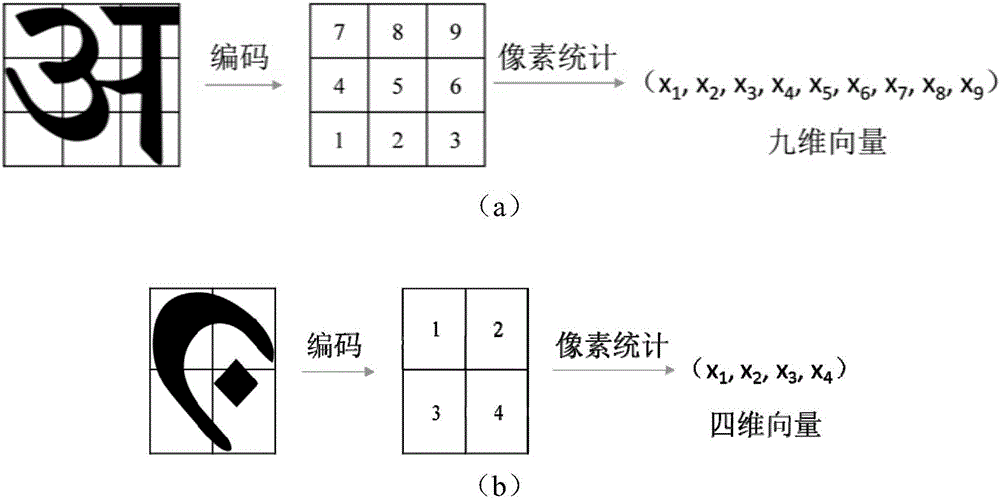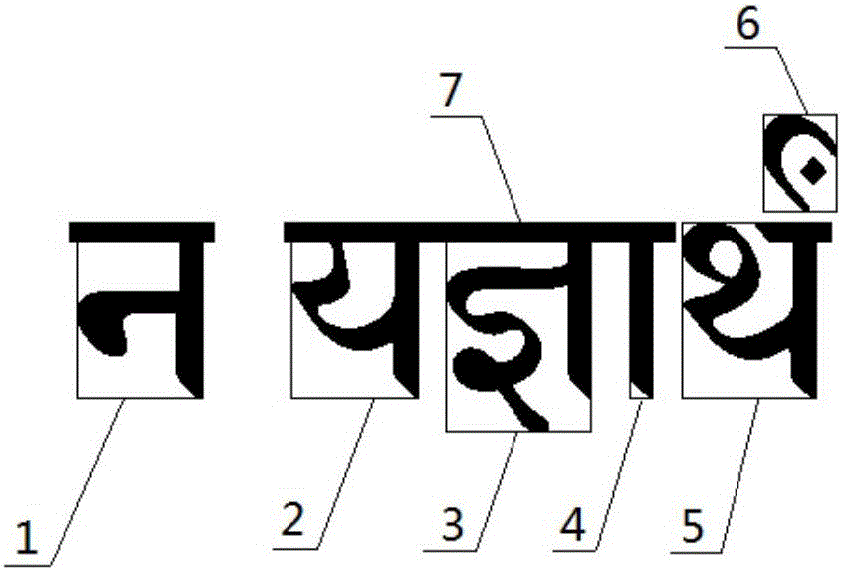Image recognition method of converting Sanskrit Devanagari printed character to Latin
An image recognition and celestial body technology, applied in character and pattern recognition, instruments, computer parts, etc., can solve the problems of less research on Sanskrit character image recognition, difficulty in character recognition, etc., to achieve high accuracy, high accuracy, and improved The effect of processing efficiency
- Summary
- Abstract
- Description
- Claims
- Application Information
AI Technical Summary
Problems solved by technology
Method used
Image
Examples
Embodiment 1
[0051] Such as figure 2 The Sanskrit Devanagari printed character picture shown above is divided into 6 Sanskrit Devanagari printed character blocks by the above-mentioned Sanskrit Devanagari printed character block segmentation method, encoded by the Jiugongge method and Tianzige method, and the pixel value and normalization processing are obtained , respectively calculate the nine-dimensional feature vector of each character block, as shown in Table 1 below:
[0052] Table 1
[0053]
[0054] Among them, the character vector numbering method adopts figure 1 The numbering method in is used for labeling; Sanskrit Devanagari printed character blocks 1~6 and connector 7 are respectively as follows figure 2 Shown; Wherein the Sanskrit Devanagari printed character blocks 1 to 5 adopt the Jiugongge method, and the Sanskrit Devanagari printed character block 6 adopts the matt method. The numbering method of the character vector x is: Jiugongge is from left to right, from bot...
Embodiment 2
[0057] Such as image 3 The shown Sanskrit printed character picture, according to the above method, obtains 11 character blocks by character block segmentation (according to figure 2 The labeling method, starting from the bottom of the connector, from left to right are Sanskrit Devanagari printed character blocks 1~8, and then starting from above the connector, from left to right are Sanskrit Devanagari printed character blocks 9~11), through the Jiugongge Or matts calculation method obtains the nine-dimensional feature vector of each character block, as shown in table 2 below:
[0058] Table 2
[0059]
[0060]
[0061] The Latin character recognition conversion after recognition is obtained by minimum variance matching: The recognition accuracy rate is 100%.
Embodiment 3
[0063] Such as Figure 4 Shown Sanskrit printed character picture, obtains 14 character blocks (numbering is the same as embodiment 2) by character block segmentation, obtains the nine-dimensional feature vector of each character block by Jiugongge and matts calculation method, as shown in table 3 below:
[0064] table 3
[0065]
[0066] The Latin character recognition conversion after recognition is obtained by minimum variance matching: karhicit, the recognition accuracy rate is 100%.
[0067] From the verification results of Examples 1 to 3, it can be known that the conversion method of the present invention has high precision and a correct rate of 100%, and has strong practicability.
PUM
 Login to View More
Login to View More Abstract
Description
Claims
Application Information
 Login to View More
Login to View More - R&D
- Intellectual Property
- Life Sciences
- Materials
- Tech Scout
- Unparalleled Data Quality
- Higher Quality Content
- 60% Fewer Hallucinations
Browse by: Latest US Patents, China's latest patents, Technical Efficacy Thesaurus, Application Domain, Technology Topic, Popular Technical Reports.
© 2025 PatSnap. All rights reserved.Legal|Privacy policy|Modern Slavery Act Transparency Statement|Sitemap|About US| Contact US: help@patsnap.com



